Shelf Life
I Am Number Six
by Erin Finnegan,

Utena, Revolutionary Girl DVD Set 2: Black Rose Saga
Rental Shelf
Ghost in the Shell: Stand Alone Complex - Individual Eleven BD
Perishable
Nothing this time
Stream Worthy
No. 6 ep. 1-7
"Corpses everywhere" totally reminds me of Utena's Black Rose Saga, which I watched last weekend.
 This second set of Utena kicks off with a recap of the Student Council Saga. I found the recap helpful, as it's been a couple months since I watched the first box. This set also ends with a recap episode, but frankly Utena can be a little confusing, so the recaps don't seem totally unnecessary.
This second set of Utena kicks off with a recap of the Student Council Saga. I found the recap helpful, as it's been a couple months since I watched the first box. This set also ends with a recap episode, but frankly Utena can be a little confusing, so the recaps don't seem totally unnecessary. The new villain is Souji Mikage, a genius student who heads a mysterious seminar. Troubled students come to be "interviewed" by Souji, but ultimately end up his mind-controlled pawns who wind up dueling Utena. In any other show, this duelist-of-the-week plot might get boring, but Kunihiko Ikuhara keeps things fresh by exploring the considerable problems of background characters. Besides rounding out the backstories of otherwise unimportant students, Ikuhara makes them unique in the Nietzschean meaning of the word: deep, dark and interesting. Almost all of the characters are somehow sexually repressed, and the mind control allows each of them to take action in a way they otherwise wouldn't dare.
Season two has the same exciting feel as season one without losing any steam. Introducing a new character like Souji seems a little off-putting at first, but I quickly became accustomed to all the new characters, including Anthy Himemiya's creepy brother.
Additionally, the reuse footage is switched up. Instead of Utena's approach to the dueling arena, we see her opponents taking a creepy elevator down into a mausoleum. The dueling arena itself spontaneously fills with objects symbolic to the plot: mementos meaningful to the antagonist's life, desks that move by themselves, and chalk corpse outlines prefigure the fate of each duelist. There's even a reoccurring cremation scene. Just like in the first season, the songs during the repeated footage are so good that you won't want to skip them (and the songs change each time).
The color booklet included with the set contains text interviews with Ikuhara and other staff members that are far more informative than the video extra, a stilted interview with Ikuhara at Big Apple Anime Festival. Across the interviews, Ikuhara says that theater influenced Utena more than anything else. (Between this, Oh! Edo Rocket and Lychee Light Club, I'm starting to wonder if theater in Japan is totally crazy.) In one intriguing interview, the background designer explains the physics-defying "set pieces" that make up the school.
I cannot emphasize enough how much brighter the picture is on this new release. I watched the first set with a yaoi translator who owned the CPM releases and she kept drooling over the picture quality (and the booklet). It's totally worth double-dipping.
It's a repeated motif in Utena that characters must "revolutionize the world," and by odd coincidence, a character in the second title I watched this week asked the question, "what do you mean by revolution?" Unfortunately, Ghost in the Shell: Stand Alone Complex - Individual Eleven didn't hold up as an OAV.[TOP]
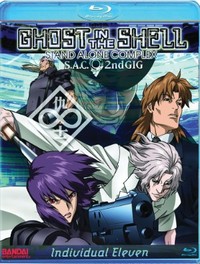 The Individual Eleven plot just doesn't hold up when cut into a movie. You're much better off watching it as a TV series.
The Individual Eleven plot just doesn't hold up when cut into a movie. You're much better off watching it as a TV series.Don't get me wrong, I love the Ghost in the Shell TV series, both seasons. This is the first time I've had the pleasure of reviewing any GitS title anywhere (other reviewers always steal it first) so I wanted desperately for this to be Shelf Worthy. If it held up, I was hoping I could loan out Individual Eleven to friends who stopped after the Laughing Man arc to get them back into the show. But now I'm not confident anyone who watched this would want to go back and enthusiastically watch the TV show.
I like the Laughing Man arc better than the Individual Eleven arc for a couple of reasons; first, as I remember it, the Laughing Man story is slightly simpler. In Individual Eleven, the characters casually throw around relatively complicated political theory jargon in the dialog. So much so that I prefer to watch GitS (especially 2nd Gig) dubbed with subs on so I can hope to process all of the information. I do want my entertainment to be smarter than I am, but when actually presented with such a title, I can have a hard time processing it.
Here is the plot, in a nutshell: Ever since the end of World War IV, Asian refugees have been living on Dejima, a Japanese island. They have become a permanent underclass, making a marginal living as manual laborers without hope of ever receiving proper citizenship. Consequently, political unrest is the norm in Dejima, but recently someone behind the scenes is trying to incite the refugees to war by manipulating them with terrorists incidents. The Major and Section Nine are on the case, and their investigation eventually leads them to pursue a cultish charismatic "hero" named Kuze.
Charismatic figures, terrorism, political unrest, and refugees are all immediately relevant to the current state of the world, maybe even more so now than when the show was written. In some ways it seems like a creepy prediction of things to come. Unfortunately, this OAV, cut from a 26 episode series, only has time for big reveals. The important, character building moments are left on the cutting room floor. In particular, episode eleven is incredibly significant to the original series, and it's only alluded to in a brief flash here. (Episode eleven – which contains backstory integral to the entire Ghost in the Shell franchise – is my favorite 2nd Gig episode, so this was a major let down.)
The Tachikomas also fall to the wayside in this OAV. Throughout the TV series they were built up as (individual) characters towards a grand finale, but here only the finale remains. The ending is still touching, but probably only if you've seen all of the TV series beforehand. Only two Tachikoma shorts are included on this disc.
For a TV series that's five years old, the video quality has held up incredibly well on Blu-ray. The CG looks so sparkly and new it could've come out last week. There are only a few character moments that I felt suffered from being seen in HD (and they were all talky political scenes).
The picture was great, but I was frustrated by the dub, which isn't the same cast as the Cartoon Network version. Batou, the Major, and even the Tachikomas have been replaced by audio doppelgangers. The cast changes are probably less distracting if you've never seen GitS, or only watched it subbed. (Look, I'm basically in love with Richard Epcar as Batou and hearing this dub felt like cheating on him.)
Although there is almost no romance in GitS, I'm always cheering on Batou and his unrequited love for the Major (indeed, at times he literally carries a cross for her). There are hints in the GitS manga that that Kusanagi prefers ladies, but since she is a brain that can be transferred between bodies, I think of her has post-gender. [TOP]
Similarly, I watched another sci-fi show with some gender issues this week.
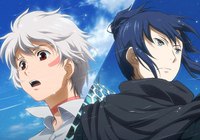 Man, why do utopias turn into dystopias so quickly? At first No. 6 appears to be an ideal future city, but we quickly learn that everything is not as pleasant at it appears.
Man, why do utopias turn into dystopias so quickly? At first No. 6 appears to be an ideal future city, but we quickly learn that everything is not as pleasant at it appears.12-year-old Sion has a promising future until he harbors a fugitive boy named Rat in the first episode. Following a time jump, episode two takes place after Sion, now 16, has lost his genius scholarships and works as a city parks employee. He soon encounters a cover-up involving crazy-deadly parasitic wasps, and is subsequently "rescued" from No. 6 by Rat, who introduces Sion to the slum outside No. 6's domed "paradise."
There are three things happening simultaneously in No. 6 that messed up my expectations for the show. First, the conspiracy and secret police in the city are signs that point to a suspense show about dystopias. Second, the wasp scenes are frightening enough for this to be a horror series. Finally, the scenes in the wasteland make the show out to be a post-apocalypse survival tale like Fist of the North Star without huge muscle men (that is, a show nothing like Fist of the North Star).
No. 6 could've easily gone in any of those directions, but instead the series focuses on Sion and Rat's intense and troubled friendship. Sion almost had a girlfriend; a blunt childhood friend named Safu once explained to him in graphic detail the ultimate point of kissing. When Sion is repeatedly reluctant to succumb to Safu's advances, she asks if he's interested in girls. He seems unsure.
Meanwhile, Rat makes a living playing female roles in an underground playhouse and implies he might not be above prostituting himself to men, a revelation that deeply upsets Sion. In fact, Sion has a much deeper, more meaningful and even intimate friendship with Rat than he did with Safu. Whether Sion and Rat's relationship is platonic or something more seems very much at the heart of No. 6's dramatic tension. The sci-fi elements that inform the plot are often secondary to the exploration of the dynamic between these two characters.
In fact, No. 6 is so effective at portraying "bromance" (now a word in the new Webster's edition) that I started to wonder who Rat was based on in the author's real life. I mean, I am on board for an intense friendship between teenage boys in the post-apocalypse. It's just a little disappointing that the first four episodes are fairly exciting, packed with exposition and suspense, and then episodes five through seven are boring and talky, as if the show's tires have sprung a slow leak. The parasitic wasp problem ought to feel more urgent, yet there is plenty of time for Sion to wash dogs at his part time job.
The pacing falls off a cliff so badly that I began to suspect the series was based on an unfinished manga (it isn't; it's based on a completed light novel series as far as I can tell). To make matters worse, a few (apparently) magical plot elements are introduced in episode seven. I wonder which book introduced those elements, because seven episodes seem a little late to start introducing such a significant paradigm shift in the narrative. Maybe later episodes will clear things up in a believable way…but I wouldn't count on it.
The early episodes and the opening theme have a unique design aesthetic that the show partially abandons by episode five in favor of alternating between generic shantytown settings and Sion's mother's bakery, which may as well be in modern day Tokyo. Did the budget run out? Did the lead designer jump ship?
Maybe I'm jumping the gun here. Maybe the show is saving money for more important episodes. Maybe it's still too early to tell with No. 6. The show has enough going for it so far to warrant the Streamworthy rating, but my patience isn't infinite…[TOP]
I'll see you next week, from a New York that is hopefully not too post-apocalyptic after hurricane Irene, perhaps with the initial set of a series I started reviewing from the middle, One Piece Collection One.

This week's shelves are from Estela:
"I knew about anime because of Sailor Moon but I thought I was too cool so I stopped watching Sailor Moon but in high school I got back into it because of Toonami but I discovered manga because of Naruto. As you can tell I have much more manga than anime and I have some figures. I must admit that anything of Sailor Moon that I posses is an accomplishment to me because I got into it late and couldn't find anymore decent priced DVDs or manga, so I've bought them over priced but I'm really happy about Kodansha USA re-releasing the manga (I've pre-ordered it already!). But my current obsession is One Piece but I'm sticking to the manga and figures, maybe later I'll buy the DVDs. And I also love Gintama so I usually buy anything and everything Gintama, it's an amazing series and everyone should read the manga or buy the anime!! I need more Nodame in my life! Oh I also have some artbooks and am quite happy about them too. I guess that's it, I hope you like them.
I forgot to mention that my sister's pitbull has a Negative Hollow on her and she doesn't look so cute but she is adorable! And my two cat's one is named Naruto (the mean looking one that's coming at you!) and the other sleepy head is Ducky, yes that is his name, blame my sister she thought it would be funny...which it is."
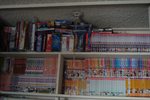


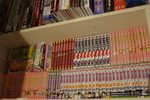


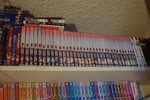















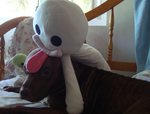
Aww, cute.
Want to show off your stuff? Send your jpgs to [email protected]. Thanks!
discuss this in the forum (45 posts) |
this article has been modified since it was originally posted; see change history